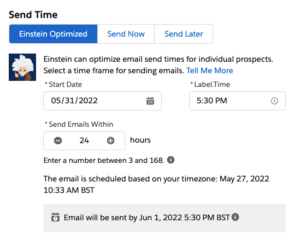Empower your Salesforce and Account Engagement users with AI-powered features from Einstein. Account Engagement (Pardot) Advanced and Premium edition customers get insights about the things they care about most. From their sales leads and accounts, through to the campaigns their prospects are engaging with and why. Let’s take a look at these intelligent features!
Einstein Behaviour Scoring
You can use Einstein Behaviour Scoring to get a tailored engagement model. This is created by looking at Lead and Contact activities captured in Pardot. Leads and Contacts are given an overall score between 0 – 100, which is weighted by recency and frequency. The score is also influenced by positive and negative factors. This is very similar to Pardot scoring, however, as it is powered by machine learning it provides a much more hands-off approach to measuring engagement.
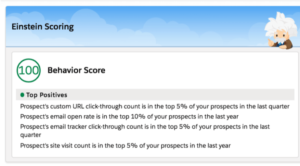
You can review how different activities influence the scoring model through a dashboard in B2B Marketing Analytics. To view the score, simply add the Einstein Scoring component to Lead and Contact Lightning pages. Alternatively, add a Behaviour Score column to your list views and then sit back and watch Einstein work its magic!
Even more, you can use Einstein Behaviour scores in your Salesforce and Pardot automation (e.g. in Flow or Engagement Studio).
There are 3 main considerations for Einstein’s Behaviour scoring:
- Firstly, at least 20 prospects must be linked to opportunities (via Opportunity Contact Roles).
- It also requires 6 months of engagement data to provide the best insights.
- Finally, only prospects linked to leads and contacts will have a behaviour score.
Einstein Lead Scoring
Make your sales teams especially happy by giving them a better idea of which leads are most likely to convert.
Similar to Pardot grading, Einstein analyses the demographic data held on your existing leads. It spots patterns in converted leads and identifies current leads which share common traits. The score takes both positive and negative information into account. Your sales team can make informed decisions about the calls they are making by using the score and associated factors.
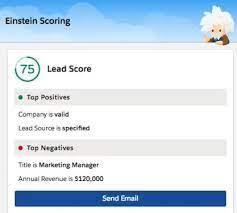
Since Lead scoring focuses on the information held on Lead records, and Behaviour scoring looks at engagement and activities, the two can work in tandem to provide you with an AI-powered alternative to standard scoring and grading.
Read more here.
Einstein Campaign Insights
This one is for all the marketers out there! Adding these insights to your Lightning pages will help you to learn what factors drive campaign performance. By revealing trends in prospect demographics and marketing asset engagement, you can optimise your campaign assets and identify key audiences.
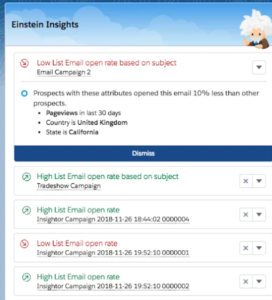
The model uses Pardot data such as job titles, industry and country alongside engagement with emails, forms and landing pages. If any of this data is missing, the data points can be expanded to include information held on the related Lead, Contact or Account record.
The insights provide you with recommendations and the rationale behind them based on data from Pardot.
The recommendations could be at a “global” level or a “segment” level:
- Global recommendations tell you that campaign X performs better than your other campaigns, or that your latest list email hasn’t performed as well as others.
- “Segment” level recommendations allow you to get even more granular by taking those prospect data points (such as job title) to tell you how segments of your audience interact with your campaign and related assets. For example, manufacturers in Birmingham engaged with your email more than anyone else.
You can enable this information on your homepage for all your marketing team, or on a campaign-by-campaign basis. Build custom reports to analyse trends across your campaigns.
Find out what else you can learn from these insights here.
Einstein Attribution
Einstein Attribution takes your historical campaign data and looks for patterns or common journeys that customers take, that influence buying decisions. A contribution is assigned to each touchpoint by scanning tasks and activities related to opportunities. Be aware! This can lead to campaigns influencing opportunities but receiving very small portions of the revenue pie and may be too granular for your reporting requirements. With Einstein Attribution, there isn’t actually a need to link contacts to opportunities (though we’d still recommend it!) as Einstein identifies the contact roles themselves.
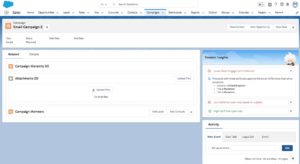
Find out more about the attribution model and the Shapley Value here.
Einstein Send Time Optimization
Send Time Optimization evaluates historical engagement data for prospects to recommend an optimal send time for that person. Einstein develops a model and applies it to each prospect by analysing opens, clicks, unsubscribes and spam complaints, as well as applying a weighting based on the frequency of email sends. This is only available for lightning-built emails.
Each prospect on a list is given an optimised send time within the timeframe you set for the email. The optimisation is only applied to prospects with at least one engagement in the last 90 days. Otherwise, a random time is selected.
You can find out more about optimising your send times here.
Einstein Engagement Frequency
Check out Kyle’s blog for the lowdown on how Einstein Engagement Frequency ensures you are delivering just the right amount of content to your audience.
Einstein Key Account Identification
Finally, as Pardot develops its Account-Based Marketing (ABM) offering, Einstein comes through with another key feature for sales teams. This model uses engagement data plus account and related object information to produce two values: a tiered ranking (from A – D) and an ‘uplift value’. The uplift value identifies whether an account is more or less likely to convert versus a randomly selected account in the same tier. So if your uplift value is 2x, this means the account you are looking at is twice as likely to convert as another account in the same tier.
Einstein also provides you with up to four key considerations about why the tier and uplift values are what they are.
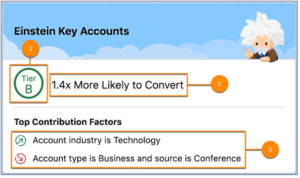
This model does require quite a lot of data to give reliable results so definitely one for larger organisations. It requires at least 200 accounts with won opportunities and 200 accounts with lost opportunities in the last 2 years.
You can find out more about identifying your key accounts here.
How to get these Einstein Features
You may be wondering how you can get your hands on these great features. Firstly, only customers with an Advanced edition or higher of Account Engagement (Pardot) will can enable these features. Secondly, all of these are lightning components. So if your sales team aren’t all using lightning yet, it’s a good reason to make the switch.
Need some support with feature or user enablement? Get in touch with one of our experts today.


